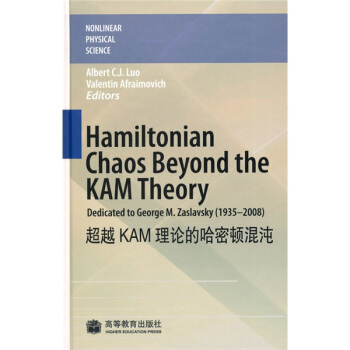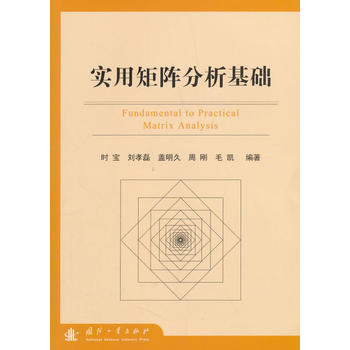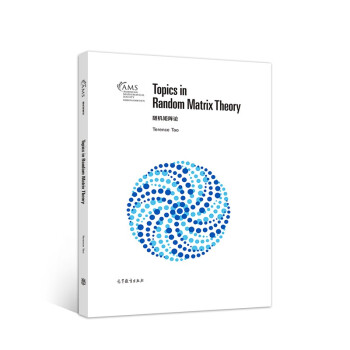

|
關(guān)于我們
 書單推薦 書單推薦 新書推薦 新書推薦 |
超越KAM理論的哈密頓混沌 
The book is dedicated to Dr.George Zaslavsky,who was one of three founders of the theory of Hamiltonian chaos.Each chapter in this book was written by wellestablished scientists in the field of nonlinear Hamiltonian systems.
《超過KMA理論的哈密頓混沌(國內(nèi)英文版)》:Nonlinear Physical Science focuses on the recent advancesof fundamental theories and principles analytical andsymbolic approaches as&
George M.Zaslavsky was born in Odessa,Ukraine in 1935 in a family of an artilleryofficer.He received education at the University of Odessa and moved in 1957 toNovosibirsk,Russia.In 1965,George joined the Institute of Nuclear Physics wherehe became interested in nonlinear problems of accelerator and plasma physics.Roald Sagdeev and Boris Chirikov were those persons who formed his interest inthe theory of dynamical chaos.In 1968 George introduced a separatrix map thatbecame one of the major tools in theoretical study of Hamiltonian chaos.The work"Stochastical instability of nonlinear oscillations"by G.Zaslavsky and B.Chirikov,published in Physics Uspekhi in 1971,was the first review paper"opened the eyes"of many physicists to power of the theory of dynamical systems and modern ergodictheory.It was realized that very complicated behavior is possible in dynamical sys-tems with only a few degrees of freedom.This complexity cannot be adequatelydescribed in terms of individual trajectories and requires statistical methods.Typi-cal Hamiltonian systems are not integrable but chaotic,and this chaos is not homo-geneous.At the same values of the control parameters,there coexist regions in thephase space with regular and chaotic motion.The results obtained in the 1960s weresummarized in the book"Statistical Irreversibility in Nonlinear Systems"(Nauka,Moscow,1970).
The end of the 1960s was a hard time for George.He was forced to leave theInstitute of Nuclear Physics in Novosibirsk for signing letters in defense of someSoviet dissidents.George got a position at the Institute of Physics in Krasnoyarsk,not far away from Novosibirsk.There he founded a laboratory of the theory of non-linear processes which exists up to now.In Krasnoyarsk George became interestedin the theory of quantum chaos.The first rigorous theory of quantum resonance wasdeveloped in 1977 in collaboration with his co-workers.They introduced the impor-tant notion of quantum break time(the Ehrenfest time)after which quantum evolu-tion began to deviate from a semiclassical one.The results obtained in Krasnoyarskwere summarized in the book"Chaos in Dynamical Systems"(Nauka,Moscow andHarwood,Amsterdam,1985).
1 Stochastic and Resonant Layers in Nonlinear Hamiltonian Systems Albert C.J. Luo
1.1 Introduction
1.2 Stochastic layers
1.2.1 Geometrical description
1.2.2 Approximate criterions
1.3 Resonant layers
1.3.1 Layer dynamics
1.3.2 Approximate criterions
1.4 A periodically forced Duffing oscillator
1.4.1 Approximate predictions
1.4.2 Numerical illustrations
1.5 Discussions
References
2 A New Approach to the Treatment of Separatrix Chaos and Its Applications
S.M. Soskin, R. Mannella, O.M. Yevtushenko, LA. Khovanov, P V.E. McClintock
2.1 Introduction
2.1.1 Heuristic results
2.1.2 Mathematical and accurate physical results
2.1.3 Numerical evidence for high peaks in ΔE(ωf) and their rough estimations
2.1.4 Accurate description of the peaks and of the related phenomena
2.2 Basic ideas of the approach
2.3 Single-separatrix chaotic layer
2.3.1 Rough estimates. Classification of systems
2.3.2 Asymptotic theory for systems of type I
2.3.3 Asymptotic theory for systems of type II
2.3.4 Estimate of the next-order corrections
2.3.5 Discussion
2.4 Double-separatrix chaos
2.4.1 Asymptotic theory for the minima of the spikes
2.4.2 Theory of the spikes' wings
2.4.3 Generalizations and applications
2.5 Enlargement of a low-dimensional stochastic web
2.5.1 Slow modulation of the wave angle
2.5.2 Application to semiconductor superlattices
2.5.3 Discussion
2.6 Conclusions
2.7 Appendix
2.7.1 Lower chaotic layer
2.7.2 Upper chaotic layer
References
3 Hamiltonian Chaos and Anomalous Transport in Two Dimensional Flows Xavier Leoncini
3.1 Introduction
3.2 Point vortices and passive tracers advection
3.2.1 Definitions
3.2.2 Chaotic advection
3.3 A system of point vortices
3.3.1 Definitions
3.4 Dynamics of systems with two or three point vortices
3.4.1 Dynamics of two vortices
3.4.2 Dynamics of three vortices
3.5 Vortex collapse and near collapse dynamics of point vortices
3.5.1 Vortex collapse
3.5.2 Vortex dynamics in the vicinity of the singularity
3.6 Chaotic advection and anomalous transport
3.6.1 A brief history
3.6.2 Definitions
3.6.3 Anomalous transport in incompressible flows
3.6.4 Tracers (passive particles) dynamics
3.6.5 Transport properties
3.6.6 Origin of anomalous transport
3.6.7 General remarks
3.7 Beyond characterizing transport
3.7.1 Chaos of field lines
3.7.2 Local Hamiltonian dynamics
3.7.3 An ABC type flow
3.8 Targeted mixing in an array of alternating vortices
3.9 Conclusion
References
4 Hamiltonian Chaos with a Cold Atom in an Optical Lattice S. V. Prants
4.1 Short historical background
4.2 Introduction
4.3 Semiclassical dynamics
4.3.1 Hamilton-Schrrdinger equations of motion
4.3.2 Regimes of motion
4.3.3 Stochastic map for chaotic atomic transport
4.3.4 Statistical properties of chaotic transport
4.3.5 Dynamical fractals
4.4 Quantum dynamics
4.5 Dressed states picture and nonadiabatic transitions
4.5.1 Wave packet motion in the momentum space
4.6 Quantum-classical correspondence and manifestations of dynamical chaos in wave-packet atomic motion
References
5 Using Stochastic Webs to Control the Quantum Transport of Electrons in Semiconductor Superlattices
T.M. Fromhold, A.A. Krokhin, S. Bujkiewicz, P.B. Wilkinson,
D. Fowler, A. Patane, L. Eaves, D.PA. Hardwick, A.G. Balanov,
M.T. Greenaway, A. Henning
5.1 Introduction
5.2 Superlattice structures
5.3 Semiclassical electron dynamics
5.4 Electron drift velocity
5.5 Current-voltage characteristics: theory and experiment...
5.6 Electrostatics and charge domain structure
5.7 Tailoring the SL structure to increase the number of conductance resonances
5.8 Energy eigenstates and Wigner functions
5.9 Summary and outlook
References
6 Chaos in Ocean Acoustic Waveguide
A.L. Virovlyansky
6.1 Introduction
6.2 Basic equations
6.2.1 Parabolic equation approximation
6.2.2 Geometrical optics. Hamiltonian formalism
6.2.3 Modal representation of the wave field
6.2.4 Ray-based description of normal modes
6.3 Ray chaos
6.3.1 Statistical description of chaotic rays
6.3.2 Environmental model
6.3.3 Wiener process approximation
6.3.4 Distribution of ray parameters
6.3.5 Smoothed intensity of the wave field
6.4 Ray travel times
6.4.1 Timefront
6.4.2 Statistics of ray travel times
6.5 Modal structure of the wave field under conditions of ray chaos..
6.5.1 Coarse-grained energy distribution between normal modes
6.5.2 Transient wave field
6.6 Conclusion
References
The stochastic web concept dates back to the 1960s when Arnold showed(Arnold,1964)that,in non-degenerate Hamiltonian systems of dimension exceeding 2,reso-nance lines necessarily intersect,forming an infinite-sized web in the Poincar6 sec-tion.It provides in turn for a slow chaotic(sometimes called"stochastic")diffusionfor infinite distances in relevant dynamical variables.
It was discovered towards the end of 1980s(Zaslavsky et al.,1986;Chernikovet al.,1987a,b,1988)that,in degenerate or nearly-degenerate systems,a stochas-tic web may arise even if the dimension is 3/2.One of the archetypal examples ofsuch a low-dimensional stochastic web arises in the 1D harmonic oscillator per-turbed by a weak traveling wave the frequency of which coincides with a multipleof the natural frequency of the oscillator(Zaslavsky,2007;Chernikov et al.,1987b;Zaslavsky et al.,1991).Perturbation plays a dual role:on the one hand,it givesrise to a slow dynamics characterized by an auxiliary Hamiltonian that possesses aninfinite web-like separatrix;on the other hand,the perturbation destroys this self-generated separatrix,replacing it by a thin chaotic layer.Such a low-dimensionalstochastic web may be relevant to a variety of physical systems and plays an impor-tant role in corresponding transport phenomena:see(Zaslavsky,2007;Chernikovet al.,1987b;Zaslavsky et al.,1991)for reviews on relevant classical systems.Inaddition,there are quantum systems in which the dynamics of transport reduces tothat in the classical model described above.The latter concerns e.g.nanometre-scalesemiconductor superlattices with an applied voltage and magnetic fied(Fromholdet al.,2001,2004).
你還可能感興趣
我要評(píng)論
|








